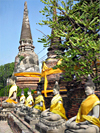|
Wat Yai Chai Mongkhon (วัดใหญ่ชัยมงคล)
Thai. ‘Great Temple of the
Auspicious Victory’. Name of a temple in
Ayutthaya,
which was presumably built in the reign of King
U-Thong,
not so long after the founding of the capital in 1351 AD, and was
initially named
Wat Pah Kaew,
but was also known as
Wat
Chao Phraya
Thai
and Wat
Phraya
Thai, as it was built to hold the ashes of
Chao
Kaew and Chao Thai, who both had
died of cholera. Its
name was changed in 1593 AD after King
Naresuan
in 1592 had a bell-shaped
chedi (fig.)
built by royal command, in order to
commemorate his
victory over the
viceroy
of
Burma, whom he had
defeated in a duel fought on the backs of
war elephants
in
Nong Sarai (fig.), near
Suphanburi
(fig.).
The scene of this battle is depicted in a mural
(fig.)
of the temple's
ubosot
and is reminiscent of a similar mural in the
wihaan
of
Wat Suwandararam,
which is depicted on a Thai postage stamp issued in 1992 (fig.).
With 2
sen,
6
wah
and 1
keub
(ca. 92 meter), the chedi of Wat Yai Chai Mongkon is the tallest in
Ayutthaya province and is enclosed within a boundary wall that on the inside has
a gallery with rows of
Buddha images,
all seated in the
bhumisparsa
pose. The chedi can be entered by climbing a steep staircase that
leads to the inner sanctum, which has several niches with Buddha
images. In the center of the chamber is a burial chamber, that
consist of a deep dungeon-like pit with at the bottom a small
stupa.
Underneath it,
in a vault in the base of the stupa a partial
sila jahreuk,
i.e.
a
stone slab with a carved
inscription, was found by workers of
the Fine Arts Department.
The
stele bears
a
Pali
incantation known as
Phra Phutta
Chai
Sitthi
Mongkon
Kata
or
[Phra]
Kata
Pha Hung (คาถาพาหุง). It
is an incantation to conquer evil and is the spell chanted by King
Naresuan each time he went into battle.
Another attraction is the temple's ruined
vihaan,
which houses
a 17 meter long reclining Buddha image (fig.),
which is positioned
with the head to the South and the face to the East. Like the vihaan,
the original built in the reign of King Naresuan was destroyed and the one seen today is a
reconstruction from 1965 AD. Worshippers come here to pray and to
enhance success they leave a coin at the foot soles of this
reclining Buddha image trying to make it stay put without falling
off (fig.). The principal
Buddha image
of Wat Yai Chai Mongkon
is
made of sandstone and is seated in the
bhumisparsa
pose. It was discovered underneath the base of the original ubosot
and lay in ruins when it was found, yet has undergone major
renovations in 1987 AD when it was restored and partly covered with
gold leaf,
making it into the eye-catching image of today (fig.).
See
PANORAMA PICTURE,
POSTAGE STAMP
and
MAP,
and
WATCH VIDEO (1) and
(2),
and
VIDEO (EN).
回






|

